主谓一致(讲解)
- 格式:doc
- 大小:27.00 KB
- 文档页数:3
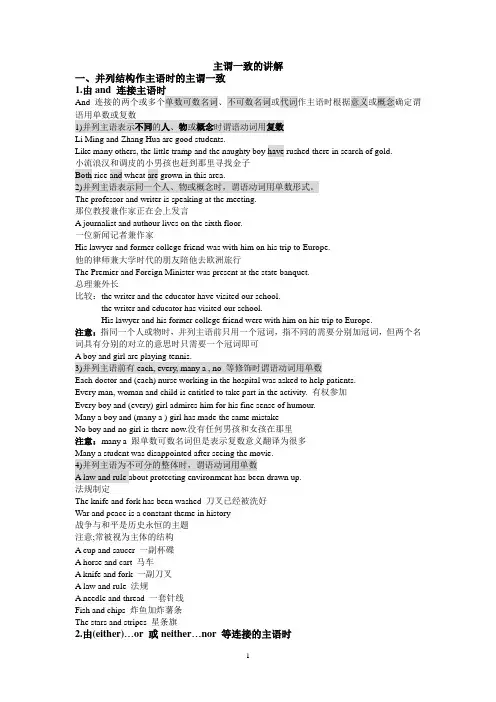
主谓一致的讲解一、并列结构作主语时的主谓一致1.由and 连接主语时And 连接的两个或多个单数可数名词、不可数名词或代词作主语时根据意义或概念确定谓语用单数或复数1)并列主语表示不同的人、物或概念时谓语动词用复数Li Ming and Zhang Hua are good students.Like many others, the little tramp and the naughty boy have rushed there in search of gold.小流浪汉和调皮的小男孩也赶到那里寻找金子Both rice and wheat are grown in this area.2)并列主语表示同一个人、物或概念时,谓语动词用单数形式。
The professor and writer is speaking at the meeting.那位教授兼作家正在会上发言A journalist and authour lives on the sixth floor.一位新闻记者兼作家His lawyer and former college friend was with him on his trip to Europe.他的律师兼大学时代的朋友陪他去欧洲旅行The Premier and Foreign Minister was present at the state banquet.总理兼外长比较:the writer and the educator have visited our school.the writer and educator has visited our school.His lawyer and his former college friend were with him on his trip to Europe.注意:指同一个人或物时,并列主语前只用一个冠词,指不同的需要分别加冠词,但两个名词具有分别的对立的意思时只需要一个冠词即可A boy and girl are playing tennis.3)并列主语前有each, every, many a , no 等修饰时谓语动词用单数Each doctor and (each) nurse working in the hospital was asked to help patients.Every man, woman and child is entitled to take part in the activity. 有权参加Every boy and (every) girl admires him for his fine sense of humour.Many a boy and (many a ) girl has made the same mistakeNo boy and no girl is there now.没有任何男孩和女孩在那里注意:many a 跟单数可数名词但是表示复数意义翻译为很多Many a student was disappointed after seeing the movie.4)并列主语为不可分的整体时,谓语动词用单数A law and rule about protecting environment has been drawn up.法规制定The knife and fork has been washed 刀叉已经被洗好War and peace is a constant theme in history战争与和平是历史永恒的主题注意;常被视为主体的结构A cup and saucer 一副杯碟A horse and cart 马车A knife and fork 一副刀叉A law and rule 法规A needle and thread 一套针线Fish and chips 炸鱼加炸薯条The stars and stripes 星条旗2.由(either)…or 或neither…nor 等连接的主语时由either…or, neither…nor, or, not only…but(also)…连接主语时,谓语动词陈述句中就近原则Either you or Jane is to be sent to New York.要么你要么简被派往纽约Neither you nor he has finished the experiment.Neither the teacher nor the students like this piece of music. 都不喜欢这首曲子Not only the old farmer but also his family were friendly to me.Not only his friends but also he himself is looking forward to taking part in the party.3.主语由肯定否定两部分构成谓语跟肯定部分走Not you but I am to answer the questionI, not you, am to answer the question.二、单一主语的主谓一致1.名词本身自带s作主语时1)学科名词: physics 物理mathematics/maths 数学economics 经济学politics政治学新闻; news体操:GymnasticsAs we know, Physics is a fundamental subject in science.物理是自然科学中的一门基础学科Mathematics is a required course for middle school students.数学是中学生的一门必修课Einstein once said ,“Politics is much more difficult than physics.”注意:当mathematics 表示运算时谓语动词用单数复数都可If my mathematics is/are right, the answer is 56.如果我的运算正确,答案就是56The television news is at 7 o’clock in the evening every dayGymnastics is my sister’s favourite sport2)有些名词单复数同行根据是单数概念还是复数概念判断谓语means方式方法aircraft 飞机works 工厂crossroads十字路口deer 鹿sheep 羊fish 鱼This works was build in 1982 这座工厂是By far, three steelworks have been closed down in this cityThis means of transport has been triedAll possible means have been tried3)由两部分组成的物体名词作主语时,谓语动词用复数chopsticks筷子compasses 圆规glasses眼镜gloves手套Jeans牛仔裤pants裤子scissors剪子shoes鞋子shorts短裤socks短袜trousers裤子My trousers are white and his clothes are black.我的裤子是白色的他的衣服是黑色的Why are your shoes so dirty?注意;如果这些词由单位词(a pair of , a suit of , a piece of , a kind of 等)修饰时,单位词的单复数决定谓语动词的单复数A pair of scissors is lying in that drawer.These kinds of glasses are popular this summer.4)表示国家、人名、书名、组织机构等的专有名词作主语时,谓语动词用单数The united States is a developed countryThe New York Times is widely read in the world.5)以-s 结尾的群岛、山脉、海峡、瀑布等专有名词谓语动词用复数The Himalayas have a magnificent variety of plants.植物种类繁多The Niagara Falls are splendid waterfalls.6)以-S结尾的名词作主语时谓语动词用复数He doesn’t eat much fruit. 他不大吃水果.He is growing fruit in the country. 他在乡下种水果.但是,当要表示种类时,它可视为可数名词,即a fruit 指一种水果,fruits 指多种水果.比较:Some fruits have thick skins. 有些水果皮很厚.3.非谓语动词或从句作主语时1)非谓语动词或从句作主语时谓语动词用单数To improve agricultural land needs a lot of money.改善耕地质量需要投入大量的资金To see is to believeSwimming is a good way to keep healthHow they will solve the problem remains to be seenWhether she will come is not known2)多个非谓语动词作主语,表达一个概念谓语用单数,表达不同概念谓语用复数Going to be early and getting up early is good for your health.早睡早起一个概念Reading books and playing table tennis are my great pleasure.读书和打乒乓球Listening, speaking, reading and writing are all important.To be strict with oneself and to be kind to others are good qualities of a person三、其他情况的主谓一致1.表示距离、时间、长度、金额、质量等的复数名词作主语时常被看作是整体谓语动词用单数这类复数名词有:miles, dollars, pounds, kilograms公斤千克, kilometres公里, centimetres,厘米millimetres毫米, seconds, hours, years等Five dollars seems a fair price 是一个公道的价格Two kilometres is not very far for the young manFive hours is a short time for such a difficult job2.如果强调数目谓语动词用复数One hundred cents make a dollarMore than twenty years have passed since they got married.3.算数中的谓语动词一般用单数形式,有时也用复数Five times eight is/are fortyFour and eight makes/make twelveSixty minus seven leaves fifty-threeForty-eight divided by six is eight4.复合不定代词作主语时谓语动词用单数Everyone something anybody nowhereEveryone in the class was surprised at the newsListen! Someone is knocking at the door.Is anyone going to tell him the news?5.each one of…, every one of …, anyone of…, one of…, 等作主语时谓语用单数Each of the girl in our class has a balloon 我们班每个女孩都有一个气球Each of the students was asked to speak for three minutes.Every one of them is familiar to me. 我对他们都很熟悉6.each , every 作形容词修饰主语时谓语动词用单数但是each 作复数主语的同位语时谓语用复数Each/Every boy in our class has a skateboard一副滑板They each have a stateboardEach/Every student has an English-Chinese dictionaryThe students each have an English-Chinese dictionary7.none of + 不可数名词谓语用单数none of,neither of, + 可数名词复数/复数代词+ 谓语动词单数复数都可either of ,None of that money in the desk is his 不可数名词None of his classmates knows the truth.= None of his classmates know the truthNeither of the statements is true = Neither of the statements are true 两种说法没有一个真实Either of the qualifications is acceptable = Either of the qualifications are acceptable8.neither 与either 做形容词修饰单数名词时谓语动词用单数Either qualification is acceptable两种资格中的任何一种都可以接受Neither qualification is acceptable9.分数百分数+ of + 名词,some of , plenty of, a lot of, lots of, most of, the rest of, all(of), half(of) 谓语常与of 后面的名词一致分数/百分数+ of + 复数名词/ 复数代词谓语动词用复数分数/百分数+ of + 单数名词/单数代词谓语动词用单数不可数名词Two thirds of the students support the plan复数名词One tenth of them are suffering from this kind of illness.复数代词Three fourths of the surface of the earth is sea单数名词Eighty percent of the employees in the company are from Beijing百分数复数名词Thirty percent of its area is flooded each year.百分数单数名词The rest of the money belongs to youThe rest of the students speak for it.Half of the apple is rottenHalf of the apples are rotten10.more(…) than one…结构作主语时More(…)than one…+ 单数名词谓语用单数More + 复数名词+ than one 谓语用复数More than two + 复数名词谓语用复数More than one white rose has bloomed in the gardenMore white roses than one have bloomed in the gardenMore than two white roses have bloomed 两个以上的的白玫瑰开了11.a number of + 复数名词谓语用复数许多的The number of + 名词谓语动词用单数…的数量A number of trees are green in AprilA great number of tourists have been to the Great WallA large number of worker were out of work because the factory was destroyed in flood.The number of students in the computer class is limited to ten.The number of workers who were out of work was 1,000.12.there/here…引导句子时就近原则There are some chairs and a table in the roomThere is a table and some chairs in the roomHere are some gifts for youHere is a book, a pen and some paper for you.13.当主语后接修饰语时With, along with, together with, but, besides, except, like, including, in addition to, as well as, rather than, 谓语动词与前面的主语保持一致A library with five thousand books is offered to the nation as a gift被作为礼物送给了这个国家The teacher, along with her students, is going to attend the lecture 听报告A peasant, together with some soldiers, is about to help us.All but one have arrived here.除了一个人外所有人都到了No one except two students was late for class.再没有其他人上课迟到The garage, in addition to the house, was burned.She as well as the other girls is going to another supermarked.You as well as I are wrong.The father, rather than the brother, is responsible.父亲而不是兄弟们应当负责14.The+ 形容词做主语时表示一类人用复数谓语表示抽象概念用单数谓语The injured were carried away on stretchers.用担架抬走了The old are more likely to catch cold than the youngThe rich are for the decision but the poor are against it.The young are always full of vitality充满了活力The unknown is always something to be feared 未知的东西总是令人害怕The beautiful is not always the good, and the good is not always the true.美未必是善善未必是真The true is to be distinguished from the false真应与假相区别The good is what people like 人们总是喜欢美好的东西In many stories, the good are well rewarded and the bad are punished.好人有好报坏人有怀抱15.all做主语时指一切表示单数概念用单数谓语,指具体人或物用复数谓语All has been tried一切都试过了All were silent 大家都一言不发All was silent 万籁俱寂All are here now 大家都在16.由a kind of, this kind of, many kinds of, 名词+of this kind, a type of a sort of 谓语动词根据of 后面的名词来定A new type of machine is on show now.Machines of this kind are made in Wuhan。
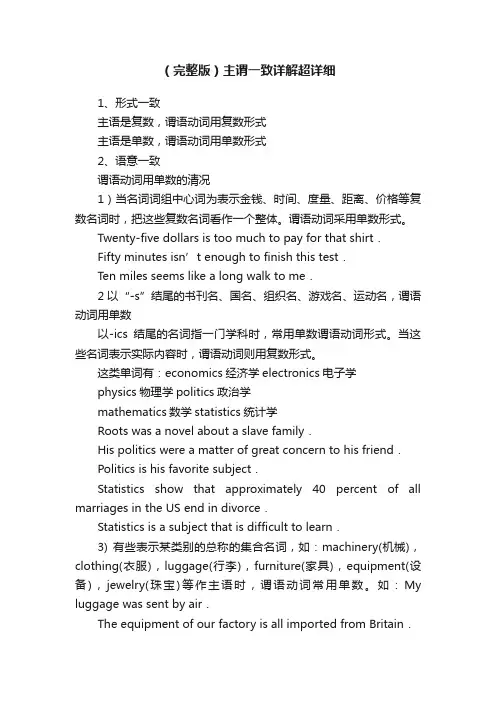
(完整版)主谓一致详解超详细1、形式一致主语是复数,谓语动词用复数形式主语是单数,谓语动词用单数形式2、语意一致谓语动词用单数的清况1)当名词词组中心词为表示金钱、时间、度量、距离、价格等复数名词时,把这些复数名词看作一个整体。
谓语动词采用单数形式。
Twenty-five dollars is too much to pay for that shirt.Fifty minutes isn’t enough to finish this test.Ten miles seems like a long walk to me.2 以“-s”结尾的书刊名、国名、组织名、游戏名、运动名,谓语动词用单数以-ics结尾的名词指一门学科时,常用单数谓语动词形式。
当这些名词表示实际内容时,谓语动词则用复数形式。
这类单词有:economics经济学electronics电子学physics物理学politics政治学mathematics数学statistics统计学Roots was a novel about a slave family.His politics were a matter of great concern to his friend.Politics is his favorite subject.Statistics show that approximately 40 percent of all marriages in the US end in divorce.Statistics is a subject that is difficult to learn.3) 有些表示某类别的总称的集合名词,如:machinery(机械),clothing(衣服),luggage(行李),furniture(家具),equipment(设备),jewelry(珠宝)等作主语时,谓语动词常用单数。
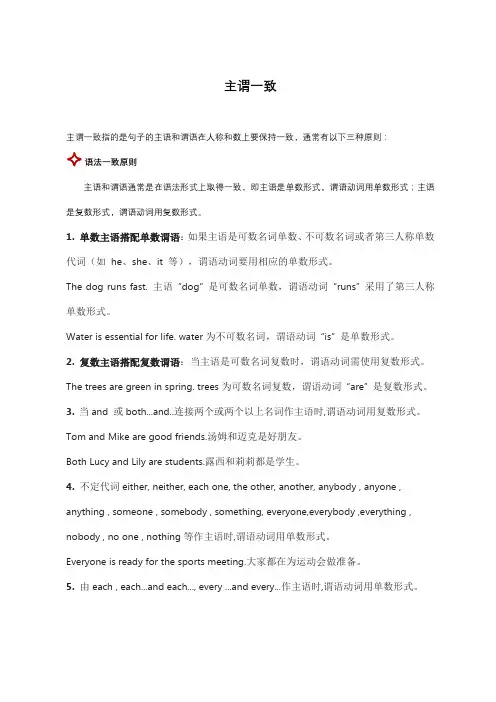
主谓一致主谓一致指的是句子的主语和谓语在人称和数上要保持一致,通常有以下三种原则:语法一致原则主语和谓语通常是在语法形式上取得一致,即主语是单数形式,谓语动词用单数形式;主语是复数形式,谓语动词用复数形式。
1. 单数主语搭配单数谓语:如果主语是可数名词单数、不可数名词或者第三人称单数代词(如he、she、it 等),谓语动词要用相应的单数形式。
The dog runs fast. 主语“dog” 是可数名词单数,谓语动词“runs” 采用了第三人称单数形式。
Water is essential for life. water为不可数名词,谓语动词“is” 是单数形式。
2. 复数主语搭配复数谓语:当主语是可数名词复数时,谓语动词需使用复数形式。
The trees are green in spring. trees为可数名词复数,谓语动词“are” 是复数形式。
3.当and 或both...and..连接两个或两个以上名词作主语时,谓语动词用复数形式。
Tom and Mike are good friends.汤姆和迈克是好朋友。
Both Lucy and Lily are students.露西和莉莉都是学生。
4. 不定代词either, neither, each one, the other, another, anybody , anyone , anything , someone , somebody , something, everyone,everybody ,everything , nobody , no one , nothing等作主语时,谓语动词用单数形式。
Everyone is ready for the sports meeting.大家都在为运动会做准备。
5. 由each , each...and each..., every ...and every...作主语时,谓语动词用单数形式。
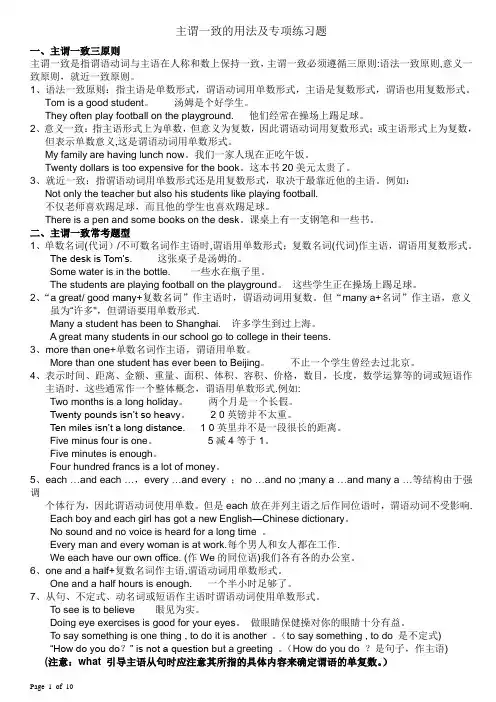
主谓一致的用法及专项练习题一、主谓一致三原则主谓一致是指谓语动词与主语在人称和数上保持一致,主谓一致必须遵循三原则:语法一致原则,意义一致原则,就近一致原则。
1、语法一致原则:指主语是单数形式,谓语动词用单数形式,主语是复数形式,谓语也用复数形式。
Tom is a good student。
汤姆是个好学生。
They often play football on the playground. 他们经常在操场上踢足球。
2、意义一致:指主语形式上为单数,但意义为复数,因此谓语动词用复数形式;或主语形式上为复数,但表示单数意义,这是谓语动词用单数形式。
My family are having lunch now。
我们一家人现在正吃午饭。
Twenty dollars is too expensive for the book。
这本书20美元太贵了。
3、就近一致:指谓语动词用单数形式还是用复数形式,取决于最靠近他的主语。
例如:Not only the teacher but also his students like playing football.不仅老师喜欢踢足球,而且他的学生也喜欢踢足球。
There is a pen and some books on the desk。
课桌上有一支钢笔和一些书。
二、主谓一致常考题型1、单数名词(代词)/不可数名词作主语时,谓语用单数形式;复数名词(代词)作主语,谓语用复数形式。
The desk is Tom’s. 这张桌子是汤姆的。
Some water is in the bottle. 一些水在瓶子里。
The students are playing football on the playground。
这些学生正在操场上踢足球。
2、“a great/ good many+复数名词”作主语时,谓语动词用复数。
但“many a+名词”作主语,意义虽为“许多",但谓语要用单数形式.Many a student has been to Shanghai. 许多学生到过上海。

主谓一致讲解及练习一、主谓一致的含义:主谓一致是指谓语动词与主语在人称和数上维持一致。
二、主谓一致三原则:主谓一致必需遵循三原则:语法一致原则,意义一致原则,就近一致原则。
(一)、语法一致原则:指主语是单数形式,谓语动词用单数形式,主语是复数形式,谓语也用复数形式。
1. 单数或不可数名词作主语,谓语动词用单数;复数名词作主语,谓语动词用复数。
如:The teache r i s here and the students ar e there .老师在这里,学生在那里。
2.each,every,neither,either,no+单数名词作主语或修饰主语时,谓语动词用单数。
如:Each room is full of people.每间屋子都挤满了人。
Each boy and girl____a new book.A.are given B.was given C.being given D.were given3.主语+with,together with,like,as well as,except, including等短语作定语时,谓语的单、复数与主语一致。
如:He as well as I wants to go boating. 他和我想去划船。
The teacher together with his students is going there on foot.老师和他的学生一路步行抵达那里。
Nobody but Jane____the secret.A.knows B.Know C.have know D.is know4.something,everything,anything,nothing,everybody,anybody,everyone,anyone,no one,nobody等复合不定代和单独的either,neither,each(each of),no one,the other,another等词作主语,谓语动词用单数。
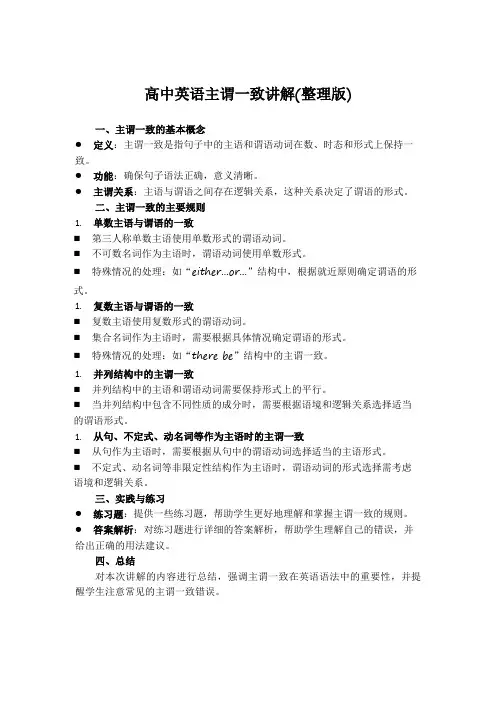
高中英语主谓一致讲解(整理版)
一、主谓一致的基本概念
●定义:主谓一致是指句子中的主语和谓语动词在数、时态和形式上保持一致。
●功能:确保句子语法正确,意义清晰。
●主谓关系:主语与谓语之间存在逻辑关系,这种关系决定了谓语的形式。
二、主谓一致的主要规则
1.单数主语与谓语的一致
⏹第三人称单数主语使用单数形式的谓语动词。
⏹不可数名词作为主语时,谓语动词使用单数形式。
⏹特殊情况的处理:如“either...or...”结构中,根据就近原则确定谓语的形式。
1.复数主语与谓语的一致
⏹复数主语使用复数形式的谓语动词。
⏹集合名词作为主语时,需要根据具体情况确定谓语的形式。
⏹特殊情况的处理:如“there be”结构中的主谓一致。
1.并列结构中的主谓一致
⏹并列结构中的主语和谓语动词需要保持形式上的平行。
⏹当并列结构中包含不同性质的成分时,需要根据语境和逻辑关系选择适当的谓语形式。
1.从句、不定式、动名词等作为主语时的主谓一致
⏹从句作为主语时,需要根据从句中的谓语动词选择适当的主语形式。
⏹不定式、动名词等非限定性结构作为主语时,谓语动词的形式选择需考虑语境和逻辑关系。
三、实践与练习
●练习题:提供一些练习题,帮助学生更好地理解和掌握主谓一致的规则。
●答案解析:对练习题进行详细的答案解析,帮助学生理解自己的错误,并给出正确的用法建议。
四、总结
对本次讲解的内容进行总结,强调主谓一致在英语语法中的重要性,并提醒学生注意常见的主谓一致错误。

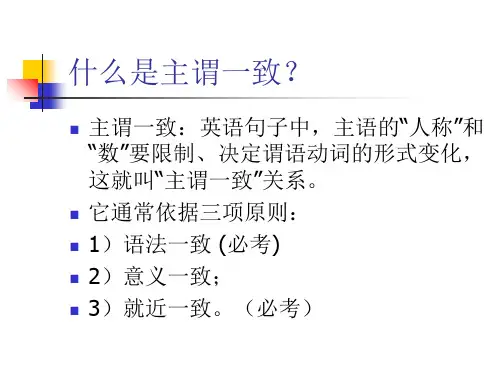

主谓一致归纳讲解主谓一致是指主语与谓语在人称和数上要相同。
在英语语法中,主谓一致是英语中最基本的语法规则之一,也是英语语法中最基础的语法点之一。
主谓一致在句子中很重要,因为它可以决定一个句子的语法结构和意义。
一般来说,主谓一致的规则很简单,主语是单数形式时,谓语也要使用单数形式;主语是复数形式时,谓语也要使用复数形式。
但是,在具体实践中,我们还需要注意一些更加细节的问题。
下面是主谓一致的一些常见归纳和讲解。
一、特殊情况当主语为集体名词时,主谓一致要看这个集体名词所表示的集体是否以整体作为主要意义,如果是以整体作为主要意义,那么谓语动词用单数形式;如果是以个体成员为主要意义,那么谓语动词用复数形式。
例如:1. The family is going to the park.(这个家庭打算去公园。
)3. The audience was very excited by the performance.(观众对表演非常兴奋。
)二、连接词导致的主谓一致问题在英语句子中,连接词和介词短语也会影响主谓一致性。
下面是一些常见的连接词以及它们在主谓一致中的作用。
1. Either…or…(要么…要么…)使用either…or…连接的两个词(或短语)都起到主语的作用,但它们中只有一个是实际的主语。
谓语动词的数应该与连接词后面的主语一致。
1. Either she or he is going to come to the party. (她或他中有一个人会来参加聚会。
)1. Neither the teacher nor the students are satisfied with the exam results.(老师和学生都对这次考试结果不满。
)3. Not only…but also…(不仅…而且…)三、主语和谓语之间的距离问题有时,主语和谓语之间有其他的词语,这可能会使人产生一些主谓一致的困惑。
1. There be 句型There be句型中的主语是there,其后紧跟着一个名词或名词短语。

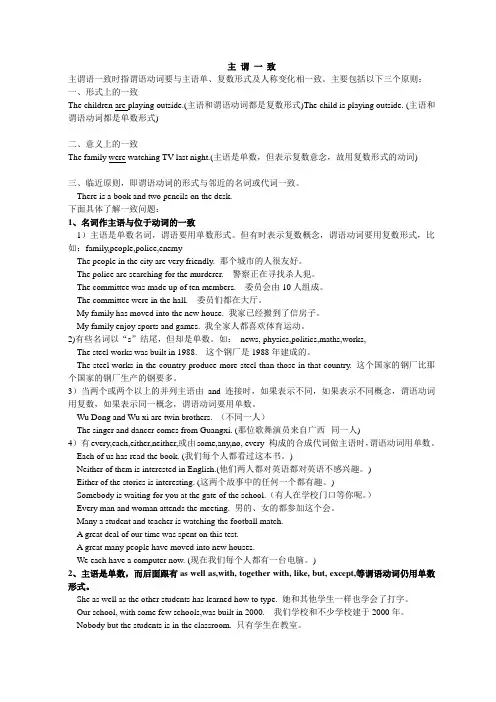
主谓一致主谓语一致时指谓语动词要与主语单、复数形式及人称变化相一致。
主要包括以下三个原则:一、形式上的一致The children are playing outside.(主语和谓语动词都是复数形式)The child is playing outside. (主语和谓语动词都是单数形式)二、意义上的一致The family were watching TV last night.(主语是单数,但表示复数意念,故用复数形式的动词)三、临近原则,即谓语动词的形式与邻近的名词或代词一致。
There is a book and two pencils on the desk.下面具体了解一致问题:1、名词作主语与位于动词的一致1)主语是单数名词,谓语要用单数形式。
但有时表示复数概念,谓语动词要用复数形式,比如:family,people,police,enemyThe people in the city are very friendly. 那个城市的人很友好。
The police are searching for the murderer. 警察正在寻找杀人犯。
The committee was made up of ten members. 委员会由10人组成。
The committee were in the hall. 委员们都在大厅。
My family has moved into the new house. 我家已经搬到了信房子。
My family enjoy sports and games. 我全家人都喜欢体育运动。
2)有些名词以“s”结尾,但却是单数。
如:news, physics,politics,maths,works,The steel works was built in 1988. 这个钢厂是1988年建成的。
The steel works in the country produce more steel than those in that country. 这个国家的钢厂比那个国家的钢厂生产的钢要多。
主谓一致最全面讲解主谓一致(concord),是指主语和谓语动词要保持人称和数上的一致。
英语中动词be的变化形式最多,如I am,You are,He is,We are等。
主语I一定要用am的动词形式,这就叫“主谓一致”。
一、主谓一致的三个原则主谓一致涉及三个基本原则,即语法一致原则(principle of grammatical concord)、意义一致原则(principle of notional concord)和就近一致原则(principle of proximity)。
A. 语法一致语法一致是指主语和谓语在单复数形式上的一致关系,主语为单数形式,谓语动词用单数形式;反之,谓语动词用复数形式。
My child has no intention of spending a vacation with me. 我的孩子不想与我一起度假。
My children have no intention of spending a vacation with me. 我的孩子们不想与我一起度假。
B. 意义一致意义一致是说谓语动词的单、复数要取决于主语所表达的概念,而不取决于表面上的语法标记。
1. 主语形式虽为单数,但意义为复数,谓语动词用复数。
The only people who are interested in the book seem to be lawyers. 唯一对这本书感兴趣的人好像是律师。
The majority of primary school teachers are women. 大多数小学老师都是女的。
2. 主语形式为复数,而意义上却是单数,谓语动词用单数。
Billiards is becoming more and more popular in some cities. 桌球在一些城市里越来越受欢迎。
C. 就近一致就近一致是指当主语由两个或两个以上名词或代词组成时,谓语动词的数要与它紧邻的名词或代词的数一致。
主谓一致 (Subject- Verb Agreement )一、主谓一致的定义:谓语动词必须在人称和数上与主语保持一致的关系。
二、主谓一致的几种特殊情况:1. 就近原则: 谓语动词的人称和数与靠近的主语保持一致e.g. Not only you but also he likes collecting stamps. Either he or I am wrong. Neither the students nor the teacher knows anything about it. There is a desk, two tables and four chairs in the office. Are either you or he going to visit the exhibition?2. 主语后面有如下词连接时,谓语动词仍视主语而定。
e.g. Tom as well as his parents is going to B.J. Nobody but the students is in the classroom. Our school with some other schools was built in the 1950s3. 主语是下列不定代词时谓语动词用单数形式e.g. Each of us has read the book. Either of the stories is interesting. Nobody wants to go there. Somebody is waiting for you.◆ none 做主语时,谓语动词单复数均可。
◆ all 自己做主语时,代表人为复数,代表物和事为单数。
◆ 不定代词如果做同位语,谓语动词随主语变化:They each have won a prize.4.主语是下列集合名词时,强调个体具体意思时用复数动词,强调全体抽象意思时用单数动词e.g. Our group were discussing on the topic. Our group is made up of fourteen boys. My family has moved into a new house. My family are all teachers.◆ people ,cattle ,police , youth 通常谓语用复数。
研究论文写作主谓一致讲解(整理版)
主谓一致是指谓语动词的单复数形式与主语的单复数形式相一
致的语法现象。
在写研究论文时,主谓一致是非常重要的,因为它
有助于增强文章的准确性和可读性。
下面是一些关于主谓一致的规则:
1. 当主语是单数形式时,谓语动词的单数形式必须使用。
例如:“猫喜欢吃鱼。
”
2. 当主语是复数形式时,谓语动词的复数形式必须使用。
例如:“猫们喜欢吃鱼。
”
3. 当主语是复数名词但表示一个整体时,谓语动词的单数形式
必须使用。
例如:“英格兰是一个有趣的地方。
”
4. 当主语是连接词“and”连接的两个或两个以上的单数名词时,谓语动词的复数形式必须使用。
例如:“猫和狗都喜欢吃鱼。
”
5. 当主语是连接词“or”连接的两个或两个以上的名词时,谓语动词的单复数形式要根据最靠近动词的名词来决定。
例如:“要么猫要么狗喜欢吃鱼。
”
总之,正确使用主谓一致是写好研究论文的重要组成部分。
只要记住这些规则,你就可以避免主谓不一致的错误,使你的论文更加流畅和易读。
主谓一致一、概念:主谓一致是指主语和谓语在人称和数上保持一致。
二、要点扫描:(一)、谓语动词用单数的情况1.由and 连接几个并列的(名词,代词,动名词,不定式……),并表示同一概念或表示不可分的整体时,谓语动词常用单数形式。
The(A) singer and dancer is to attend our evening party.那位(一位)歌舞演员将参加我们的晚会。
Trial and error is the source of our knowledge.不断尝试是我们获得知识的源泉。
Early to bed and early to rise is a good habit.When and where to hold the meeting has not been decided.2.由and连接的并列单数主语前如果分别有no, every , each , more than one , many a (an)修饰时,谓语动词常用单数形式。
every…and every … / each …and each… /many a …and many a … / no…and no…Every student and every teacher is in the room.No boy and no girl likes it.3表示距离,时间,金钱,书名等的词做主语时, 谓语动词常用单数形式。
Three years has passed since then.Six hundred miles is a long distance. 4.不定式,动名词,从句做主语时,谓语动词常用单数形式。
Smoking is a bad habit.To see is to believe.What we need is more time.5.many a+ 单数名词/ more than one + 单数名词做主语时,谓语动词常用单数形式。
Many a student has passed the English exam.More than one student has read the book.(二)、谓语动词用复数的情况1. and 连接(名词,代词,动名词,不定式),表示多个概念时,谓语动词常用复数。
A singer and a dancer are performing .Tom and Jack are close friends.When to hold the meeting and where to hold the meeting are two important things.2. 集合名词people, cattle,police……做主语时,谓语动词常用复数。
The police are searching for the thief.The cattle are in the shed. 牛在栏内。
3.The + adj. / p.p.表示一类人或事物时,谓语动词常用复数。
这类词有:the brave, the poor, the rich, the blind, the young, the old, the sick, the dead, the deaf and dumb, the injured, the wounded, the unemployed等The wounded have been sent to the hospital.The blind study in special schools.4. 成双成对的词glasses, trousers, shoes,compasses, chopsticks, scissors……做主语时,谓语动词常用复数。
Dark glasses are very useful when the sunlight is strong.注意:若该类名词前有 a pair of / a kind of / a series of 等修饰时,则由kind, pair, series 的单复数来决定。
A pair of shoes is on the desk.Ten pairs of shoes are on sale.三、不确定的情况1. 由意义决定谓语1)单复数同形的词作主语单、复数同形的名词作主语时,谓语单词应根据意义决定单、复数,这类词有:deer, fish, sheep, Chinese, Japanese, means等。
Some sheep are over there.2) 集合名词作主语①某些集合名词,如family,team等作主语时,如果作为一个整体看待,谓语动词用单数形式,如果就其中个体成员而言,谓语动词用复数形式。
这类名词有:audience, class, club, company, crew, enemy, crowd, government, group, party, public, team等。
The whole family are watching TV.②某些集合名词,如people, police, cattle等,只当复数看待,谓语动词必须用复数。
The police are searching for the thief.3) all, most, half, rest,some, none等作主语,表示复数意义,谓语动词用复数;表示单数意义,谓语动词用单数。
All of my classmates work hard.2. 由名词决定谓语的单复数1)“分数或百分数+ of +名词”作主语,其谓语动词要与of后面的名词保持一致。
50% of the students are for the opinion.2) 名词+ with,together with, along with, as well as, rather than, more than, no less than, besides, except, but, like, including等引起的短语作主语时,谓语动词与最前面的名词保持一致。
Tom as well as two of his friends was invited to the party.3) “a lot of, lots of, plenty of,…等+可数名词复数或不可数名词”构成的短语作主语时,其谓语动词要与of后面的名词保持一致*a quantity of/ quantities of +pl/un.做主语谓语与quantity 的单复数保持一致。
an amount of/ amounts of +(un) 做主语谓语与amount 的单复数保持一致。
Lots of damage was caused by fire.3. 就近一致原则当两个主语由there be; either…or…; neither…nor…; whether…or..; not only…but also…; not…but…; …or…连接时,谓语动词和邻近的主语一致。
Either you or he is to go.4. 关系代词who, that, which 等在定语从句中作主语时,其谓语动词的数应与句中先行词的数一致。
Those who want to go please put up your hands.I, who am your best friend, will help you.5. 谓语动词由主语的中心词决定1)the number of +(pl)+v.(单数) A number of +(pl)+v.(复数)The amount of +(un)+v.(单数) An amount of +(un)+v.(单数)The number of students in my class is over 60 and a number of them are girls.2) This kind of men +v.(单数) Men of this kind + v. (复数)This kind of men is dangerous.Men of this kind are dangerous.3)Each of them +v.(单数) They each +v.(复数)Each of the stones weighs 5 tons.The stones each weigh 5 tons.框架结构一. 用单数的情况1. 由and连接(名词,代词,动名词,不定式),表示同一概念。
2.and 连接并列单数主语many a …and many a…; no….and no…3.表示距离,时间,金钱,书名常用单数。
4.从句,不定式做主语二.用复数的情况1. 由and连接(名词,代词,动名词,不定式),表示多个概念。
2.集合名词people, cattle, police…3.The + adj.表示一类4. 成双成对的词glasses, trousers, shoes…+v.(复数)该类名词前有量词,则有量词决定如a pair of …三.不确定的情况1. 由意义决定谓语1)单复数同形的词如sheep, deer2) 集合名词family, team, class…3) all, most, half, rest, some, none…2.由名词决定1) 分数,百分数+名词2)名词+with/together with/ as well as…3)a lot of /lots of /plenty of+(pl/un*a quantity of/ quantities of +(pl/un.)由quantity 决定。
an amount of/ amounts of +(un) 由amount 决定。
3.就近原则there be; either…or…; neither…nor…; not only… but also…4.关系代词在定语从句中做主语时,谓语由先行词决定One of +(pl) who…+(复数)The only one of +(pl) who…+单数5. 谓语动词由主语的中心词决定1)the number of +(pl)+v.(单数) A number of +(pl)+v.(复数) The amount of +(un)+v.(单数) An amount of +(un)+v.(单数)2)This kind of men +v.(单数) Men of this kind + v. (复数)3)Each of them +v.(单数) They each +v.(复数)。